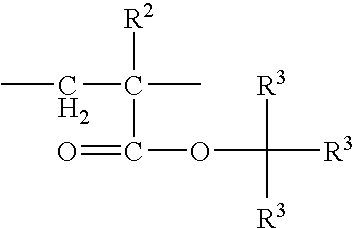Thermoplastic elastomer composition and molded article
a technology of thermoplastic elastomer and composition, which is applied in the field of thermoplastic elastomer composition and molded articles, can solve the problems of poor moldability of thermoplastic polyurethane sheets, insufficient abrasion resistance, flexibility and oil resistance of sheets using polyolefin resins and styrene elastomers, and the fear of great adverse effects on the environment, etc., to achieve excellent moldability and heat resistance, maintain weather resistance, adhesion flexibility and abrasion resistan
- Summary
- Abstract
- Description
- Claims
- Application Information
AI Technical Summary
Benefits of technology
Problems solved by technology
Method used
Image
Examples
preparation example 1
Synthesis of (MMA-co-BA-co-TBMA)-b-BA-b-(MMA-co-BA-co-TBMA) Type Acrylic Block Copolymer (Hereinafter, Described as “the Precursor 1”)
[0228] Following operations were carried out in order to obtain the precursor 1. After the atmosphere of a 15 L pressure resistant reactor was purged with nitrogen, 13.6 g (95 mmol) of copper bromide was weighed and 146 g of acetonitrile (treated with nitrogen bubbling) was added. After stirring by heating at 70° C. for 30 minutes, 19.0 g (53 mmol) of diethyl 2,5-dibromoadipate as an initiator and 1664 g (13.0 mol) of BA were added. The mixture was stirred by heating at 85° C. and 1.65 g (9.5 mmol) of pentamethyldiethylenetriamine as a ligand was added to initiate polymerization.
[0229] About 0.2 mL of the polymerization solution as for sampling was extracted from the polymerization solution periodically from the start of polymerization and the conversion of BA was determined by the gas chromatogram analysis of the sampling solution. Polymerization ...
preparation example 2
Synthesis of (MMA-co-EA)-b-(BA-co-TBA)-b-(MMA-co-EA) Type Acrylic Block Copolymer (Hereinafter, Described as “the Precursor 2”)
[0234] The following operations were carried out in order to obtain the precursor 2.
[0235] A 500 L reactor purged with nitrogen was charged with 71.83 kg of n-butyl acrylate, 3.23 kg of t-butyl acrylate and 0.804 kg of cuprous bromide to initiate stirring. Then, a solution in which 1.12 kg of diethyl 2,5-dibromoadipate was dissolved in 6.59 kg of acetonitrile was charged thereto and the inner solution was stirred for 30 minutes while flowing warm water into jacket and raising the temperature of inner solution to 75° C. When the inner temperature reached at 75° C., 97.1 g of pentamethyldiethylenetriamine was added to initiate the polymerization of an acrylic polymer block. Polymerization speed was controlled by adding pentamethyldiethylenetriamine at polymerization as needed. Pentamethyldiethylenetriamine was added 3 times in total (291.3 g in total) durin...
preparation example 3
Synthesis of (MMA-co-EA)-b-(BA-co-GMA)-b-(MMA-co-EA) Type Acrylic Block Copolymer (Hereinafter, Described as “the polymer 3”)
[0242] The following operations were carried out in order to obtain the precursor 3. After a 15 L pressure resistant reactor was purged with nitrogen, 6.45 g (45 mmol) of copper bromide, 712 g (5.6 mol) of BA and 54 g (0.38 mol) of GMA were charged thereto to initiate stirring. Then, a solution in which 9.0 g (25 mmol) of diethyl 2,5-dibromoadipate as an initiator was dissolved in 67 g of acetonitrile (treated with nitrogen bubbling) was charged thereto and the inner solution was stirred for 30 minutes while raising the temperature of the inner solution to 75° C. When the inner temperature reached at 75° C., 0.78 g (4 mmol) of pentamethyldiethylenetriamine as a ligand was added to initiate polymerization of an acrylic polymer block.
[0243] About 0.2 mL of the polymerization solution as for sampling was extracted from the polymerization solution periodically ...
PUM
| Property | Measurement | Unit |
|---|---|---|
| Percent by mass | aaaaa | aaaaa |
| Percent by mass | aaaaa | aaaaa |
| Percent by mass | aaaaa | aaaaa |
Abstract
Description
Claims
Application Information
 Login to View More
Login to View More - R&D
- Intellectual Property
- Life Sciences
- Materials
- Tech Scout
- Unparalleled Data Quality
- Higher Quality Content
- 60% Fewer Hallucinations
Browse by: Latest US Patents, China's latest patents, Technical Efficacy Thesaurus, Application Domain, Technology Topic, Popular Technical Reports.
© 2025 PatSnap. All rights reserved.Legal|Privacy policy|Modern Slavery Act Transparency Statement|Sitemap|About US| Contact US: help@patsnap.com



